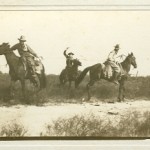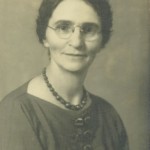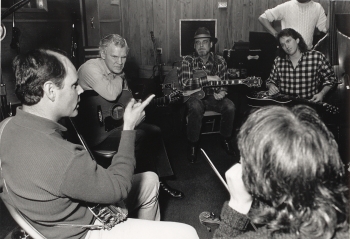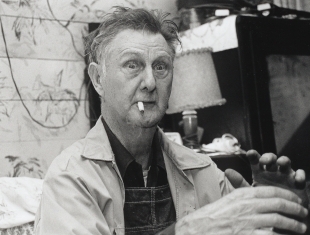“That Old Story Reminds Me of a Song” by David Holt
Storytelling Magazine January 2011 –“Storytelling and Music Connections.”
Music and story flow together like streams to a river. They naturally roll into one another and create an irresistible current.
I grew up in a Texas family where storytelling was just a way of life, nothing formal or rehearsed, just folks sitting around telling about our wild and wooly ancestors.

My Grandfather, Dick Holt (center)-Texas 1910
“That ol’ boy, John Pancake, came into your grand daddy’s doctor’s office carrying his severed left arm in his right hand. Says, ‘Doc Lowrey, can you sew it back on?’ He was just as calm as a cucumber. Your granddad said, “No, it’s too torn up, but let me sew up that shoulder.’ When he got the bleeding stopped, Doc Lowrey says, “John, what are you going to do with that other old arm of yours? Can I have it? I’ve got a project I’m working on.’ So, Mr. Pancake gives Doc Lowrey his severed arm and Doc proceeds to use the bones from that arm to make a mold for the first plastic skeleton you see in every doctor’s office in the country.”
That was the kind of storytelling I grew up hearing, raw but interesting as hell. Things like: “Son, your grandmother, Nannie, had all 32 teeth pulled in one sitting…with no anesthetic…that is how tough she was.”

My Grandmother, Nannie, Kate Lowrey
I encountered the same kind of true-life tale telling in the Blue Ridge Mountains when I came to learn clawhammer banjo from the old-timers in the summer of 1969. I came to The storytelling went right along with the music. I felt right at home.
The idea of professional storytelling had never entered my mind. When I started performing around 1974 it was just natural to tell some of the anecdotes and stories I heard while collecting the songs I was playing. “Here is a tune from Fred Cockerham, a wonderful banjoist and fiddler from Surry County, NC. Old Fred was a dour sort of fellow. In fact, when he asked his future wife if she wanted to marry, he simply said, ‘You want to be buried with my people.’ He was no romantic, but he sure could play.”
Music and stories just naturally go together. They use different parts of the mind and an evening that includes both is soul satisfying. I can guarantee if you get a bunch of musicians together to play for fun there will be stories told whether you have backwoods pickers or a group of road-worn professionals. (Some of the best storytellers anywhere are Nashville studio musicians). Musicians will play a bunch of songs or tunes and then there will be a lull. In that down time someone is bound to tell about something interesting that happened.
Musician 1: “Did you read about the old lady who was walking down Elm Street in downtown Dallas and a robber comes up with his hand under his shirt and says, ‘Give me your purse or I’ll shoot you.’ She says, ‘You can’t have my purse so go ahead and shoot me.’ So the guy actually shoots her and runs off without taking her purse. Luckily, he just grazed her and she is okay.”
Musician 2: “When I was a kid my granddad used to work downtown close to Elm Street. They called it Deep Ellem. He used to take me into the black neighborhood to get our shoes shined. He knew all the guys and which one gave the most rhythmic shine…snapping rags and clicking shoe brushes. It was an amazing thing for a 7 year old boy…probably the first really good live music I ever heard.
“Hey, you guys know the Deep Ellem Blues… the one that goes:
‘If you go down to Deep Ellem keep you money in your shoes
The women in Deep Ellem got them Deep Ellem blues.’”
And off the group will go playing another round of tunes!

David Holt, Doc Watson, Duane Eddy, Jerry Douglas, Mark O'Conner, working on Grandfather's Greatest Hits CD
In all my years of collecting music and stories in the mountains I have rarely come across a traditional folk tale teller. The Hicks family and the Harmon Family are the only ones I have ever met that really knew the folk stories. I am sure before the days of radio there were many traditional tellers but by the late 1960s most of these had died. Lots of folks knew “about” the Jack tales but to find someone who could really tell one from beginning to end was rare. Stories based in reality have always flourished and there were some great natural tellers. Jesse James Bailey, the sheriff of Madison County, NC during prohibition, was a natural (I have posted some of his tales on youtube). Without a doubt he “enhanced” the truth but that was part of the fun.
I should add that even Ray Hicks, the greatest non-stop talker I ever encountered, would occasionally stop, reach in his bib overalls and pull out an old harmonica and burst into “Short Life of Trouble.” Ray knew music and stories went together like biscuits and gravy.
Nothing has been more rewarding in my career than collecting music and stories from the old- timers. Here are a few suggestions for collecting and learning from mentors:
1. Take your time. You can’t rush the relationship. Your informant has to trust you and know that you will not misuse the things he is going to tell you. Most old folks are more than happy to share with younger enthusiasts but they have to know you are going to value and respect what they are going to impart to you. I usually build up a relationship over years.
2. Be a giver, not just a taker. Observe what your informant needs and pitch in and help. When I used to visit Ray and Rosa Hicks I would always take a box of groceries with me: basic items like beans, potatoes, onions, a ham etc. They always appreciated it since they had very little money. Yet when I was getting to know Doc Watson to bring him basic food would have been an insult. Being blind what he and his wife Rosa Lee need was help like putting things up on a high shelf, restacking the wood pile and since they both had allergies, vacuuming the house. Etta Baker loved to have photos of herself and her family. I always made sure she got copies of the pictures I shot. I had postcards made of the best shot of her and gave her 1000 copies (she loved that).
3. Get a high quality digital recorder or video unit. When I was young and had no money I recorded on cheap tape with lousy machines. This is something I will forever regret since some of the best material was collected in those early days.
4. If you are a photographer take lots of photos. If you are not, learn how to take good photographs of your subjects and use the best equipment you can afford. As it turns out, some of my most valuable collections are the photographs. There are many cases where I have one of the only good photos of a subject.
5. Acknowledge your sources. We all want to be valued and remembered. When you tell a story or sing a song from one of the people you have collected from tell about them. Give the audience a feel for what they are like and why their life makes a difference.
Today, I try to incorporate my stories seamlessly into my music performance. I don’t want the audience to be aware they are being told a story. My goal is to create a flow of music and story so compelling that it allows the listeners to completely relax and float down stream with me.
David Holt

Ray Hicks telling a story- Photo by D.Holt
